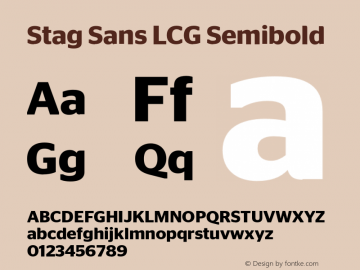Stag Slab Serif Font Examples


Slab-serif type on the heading of a poster, 1848. Some headings and the lower passage are in type, but much body text is slab serif. Statistische Methoden Der Vwl Und Bwl Ebook Download. In, a slab serif (also called mechanistic, square serif, antique or Egyptian) is a type of typeface characterized by thick, block-like serifs. Serif terminals may be either blunt and angular (), or rounded (). Slab serifs were invented in and most popular during the nineteenth century. Slab serifs form a large and varied genre.
A continuously updated collection of the 10 most popular slab serif web fonts based on font usage data from Typewolf between 2013 and 2018. Stag is a typeface superfamily published by Commercial Type. It first originated as a slab serif, commissioned by Esquire for their magazine headlines.
Some such as and have a geometric design with minimal variation in stroke width: they are sometimes described as sans-serif fonts with added serifs. Others such as those of the genre have a structure more like most other serif fonts, though with larger and more obvious serifs. These designs may have bracketed serifs which increase width along their length before merging with the main strokes of the letters, while on geometrics the serifs have a constant width. Display-oriented slab serifs are often extremely bold, intended to grab the reader's attention on a poster, while slab serifs oriented towards legibility at small sizes show less extreme characteristics. Some fonts oriented towards small print use and printing on poor-quality paper may have slab serifs to increase legibility, while their other features are closer to conventional book type fonts. Slab serif fonts were also often used in typewriters, most famously, and this tradition has meant many text fonts intended for computer and programming use are slab serif designs. A sample of the typeface, a slab serif face based on strike-on typewriting faces. Star Wars Battle Of Endor Game Modder.
Slab serif lettering and typefaces appeared rapidly in the early nineteenth century, having little in common with previous letterforms. As the printing of advertising material began to expand in the early nineteenth century, new and notionally more attention-grabbing letterforms became popular. Poster-size types began to be developed that were not merely magnified forms of book type, but very different and bolder. Some were developments of designs of the previous fifty years: ultra-bold types known as, which were related to ' text faces of the period but much bolder. Others had completely new structures: letters, based on classical antiquity, and letterforms. Some of the type designs appearing around this time may be based on signpainting and architectural lettering traditions, or vice versa. The first known example of a slab-serif letterform is woodblock lettering on an 1810 lottery advertisement from London.